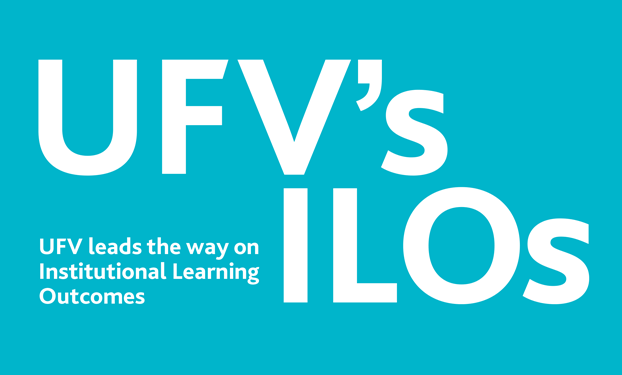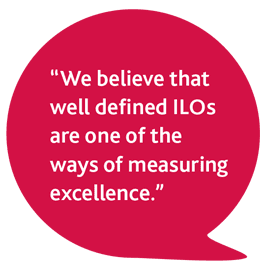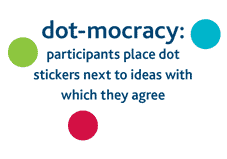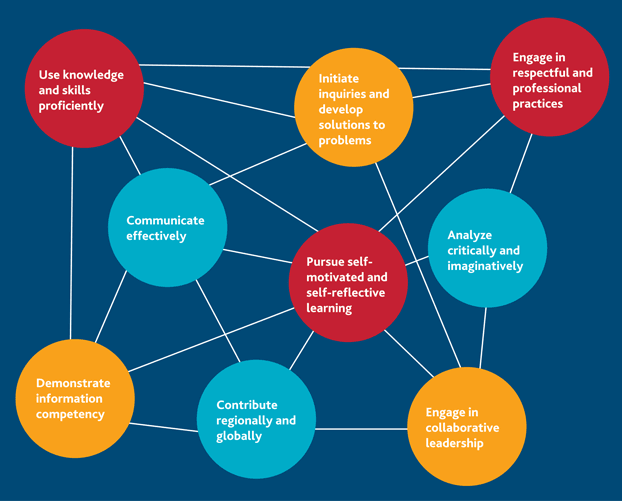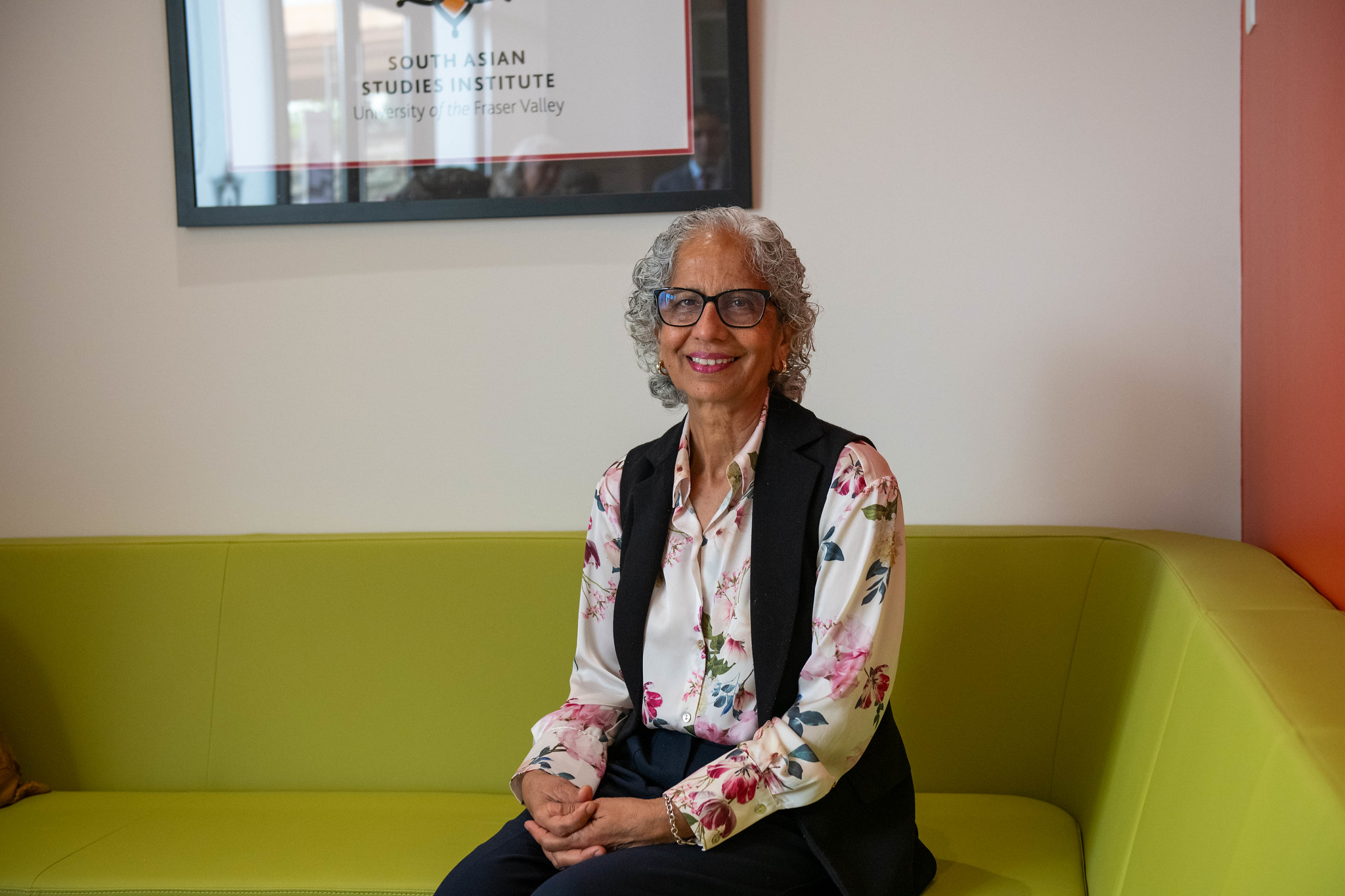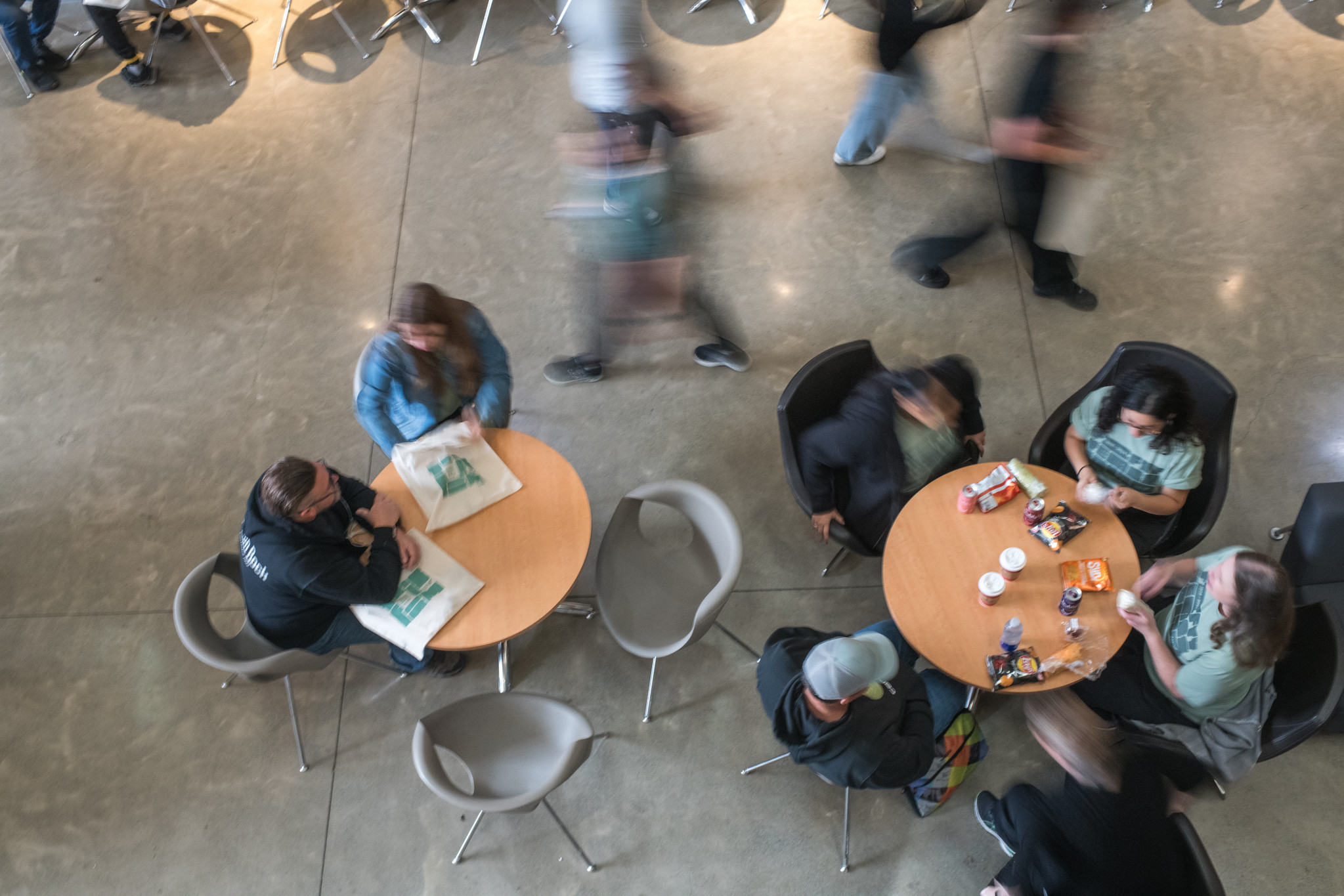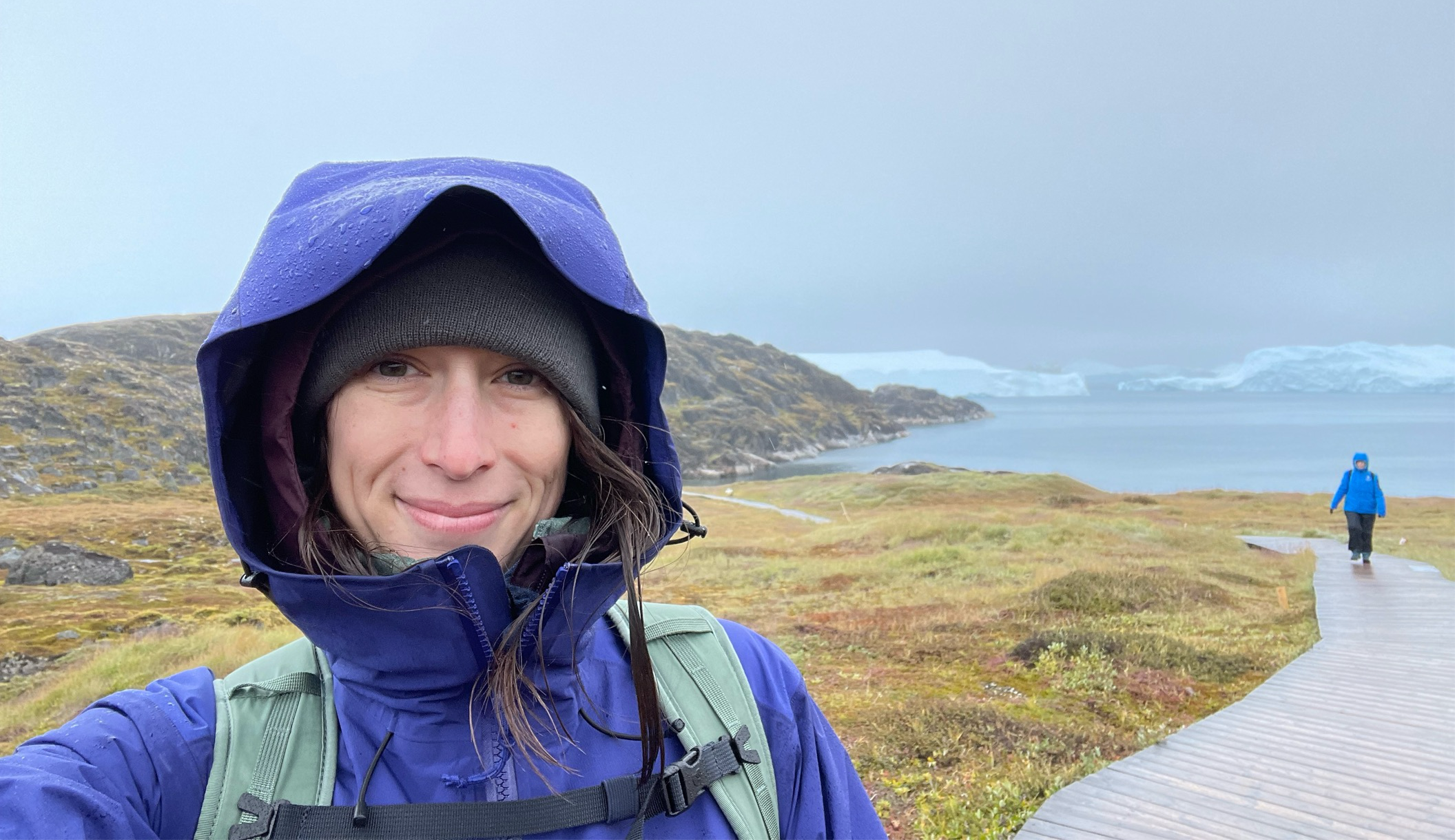Institutional Learning Outcomes provide “value-added” education for every UFV grad
A university education should consist of more than the accumulation of a body of knowledge in a certain discipline.
That’s the premise of a process that’s been ongoing at UFV since 2011. Many people have brainstormed, planned, deliberated, contributed, and worked together to create the university’s Institutional Learning Outcomes. The ILOs, as they are known, are a set of knowledge, skills, and abilities that the UFV community has collectively decided that every graduate should be able to demonstrate that they possess.
And by every graduate we mean everyone from a criminology or social work student finishing his or her master’s degree, to a welding student graduating with a 10-month entry-level trades training certificate, to a bachelor’s degree student majoring in history or biology. Students with disabilities taking the TASK workplace training program, nursing students preparing for a healthcare career, future teachers and future carpenters — they’re all included.
Choosing a set of benchmarks that one could reasonably expect each of the more than 2,000 students who graduate from UFV each year to have achieved was an intense and highly consultative process.
The process was initiated by UFV provost and vice president academic Eric Davis, as a way of ensuring that the university had a voice in determining its own vision of UFV graduates’ ideal learning outcomes.
“The drive to create learning outcomes at the institutional, program, and course levels is an unstoppable, international phenomenon,” said Davis. “It is a response both to top-down pressure from outside the institution to be accountable to governments, accreditors, employers, students, and parents, and, more fundamentally, to a bottom-up desire on the part of educators to improve the quality and real-world relevance of student learning and enhance the likelihood of student success. A learning outcomes exercise, when done well and from the bottom up, is about education, pedagogy, and transformation: transformation of students, ourselves, our communities, and the world.”
“We wanted to get a head start on the process, as we were getting messages from the provincial government that if institutions didn’t develop their own outcomes, they would do it for us,” notes Wendy Burton, UFV’s director of teaching and learning, who facilitated the ILO consultation in the 2011/12 academic year and is guiding its implementation in 2013.
UFV’s strategic goals include providing the best undergraduate education in Canada, and the learning outcomes provide a way of defining what “best” means.
“We believe that well defined ILOs are one of the ways of measuring excellence,” Burton says. “Not only can a science graduate say ‘I am a good biologist’ because of the content of their curriculum and educational experience, they will also have defined ‘bonus’ attributes related to areas such as communication, ethics, leadership, and critical analysis.”
In the tradition of internal and external community consultation that has defined UFV since its inception in the mid-1970s, Burton, assisted by Scott Varga and Ruby Ord, conducted a very intensive consultation process over the course of the academic year, guided by the Teaching and Learning Advisory Council.
They held internal forums, attended faculty councils and department meetings, and presented the project to the Minister of Advanced Education and the Alumni Association board.
They also visited community groups, churches, temples, and mosques, as well as Rotary Clubs, Kinsmen clubs, Abbotsford Community Services, Mission Indian Friendship Society, Soroptimist clubs. These visits culminated in a community-wide “charette”.
Participants learned about the charette process, which gathers creative ideas in a brainstorming environment, and engaged in idea-generating and refining methods such as drawing their image of a certain goal and “dot-mocracy”, in which participants place dot stickers next to ideas with which they agree.
UFV education instructor Sheryl MacMath agreed to take all submissions up to February, 2012 and create a synthesis draft, which was circulated widely.
A draft of the ILOs was presented on posters for a Provost’s Forum in March. Participants were encouraged to edit, annotate, revise, and contribute.
A UFV-wide professional development day was held and attended by 152 participants. At the conclusion of the opening session, all were given the opportunity to say one word that answers the question, “what is a university?” At the end of that day a penultimate draft was created using all feedback and suggestions to that date by four volunteer editors.
This team of editors worked on the document for an additional two weeks, and presented their final version at Teaching and Learning Advisory Council. It received final approval from UFV’s Senate.
In the end, hundreds of community members, instructors, students, staff members, and administrators had a hand in shaping the outcomes, which collectively define the UFV graduate.
Burton says that many factors are combining to make universities more accountable these days.
“International protocols such as The Bologna Accord (which facilitates transfer of credits between European universities) are asking what a person with a BA should have achieved. In the U.S., the Department of Education is asking ‘what does a credential mean?’ In Canada, with the ongoing mini-recession, potential students and their families are asking, ‘what will I actually get for the cost of my education?’ And governments are saying they want quality assurance if they are going to be providing a significant part of our funding.”
UFV is the first public post-secondary institution in BC in recent years to ratify formal institutional learning outcomes.
Now that the Institutional Learning Outcomes have been approved, it’s time to bring them to life and put them into action.
The focus for the 2012/13 academic year has been alignment of the specific learning outcomes of individual programs with the defined ILOs.
“By the end of this year every department will have articulated their particular program outcomes and demonstrated how they feed into the institutional ones,” says Burton.
The next phase will see every department examining every one of its courses and field experiences to determine whether what it is offering is relevant to the overall ILOs and its own learning outcomes, and seeking to eliminate redundancies in course content.
The fourth phase is prioritization, looking for what needs to be added to the curriculum to ensure all the outcomes are addressed.
When all is said and done, not only will every program be well prepared to articulate its outcomes and how they align with the institutional ones, they will be better equipped to deal with mature students who come into the system with considerable life and career experience that they may wish to receive credit for through the Prior Learning Assessment and Recognition process.
“A person will be able to come in and say, ‘I have some of that, or all of that. How can I receive credit for it?’” Burton notes.
The concept of learning outcomes also ties into the co-curricular record, a concept being implemented at UFV that will formalize recognition of UFV activities that students engage in outside of course times, such as volunteerism, club activity, or working for the student newspaper.
Burton adds that having institutional learning outcomes that cover areas such as critical analysis, self-reflective learning, effective communication, and problem solving helps to differentiate UFV as more than simply a skills-training or fact-acquisition facility.
“Students are getting more from their encounter with our institution than basic skills, and defining our ILOs helps us to articulate that, and to highlight the quality of our education and explain why our programs are as intensive and long in duration as they are,” she explains.
“The process we used to arrive at our list is also the best example of UFV’s approach to learning. It was participatory, and was recognized as an ongoing and evolving conversation with our various communities. UFV is in constant dialog with its communities. That is one of our biggest strengths. We are of our community, and these objectives arise from our community.
“The institutional learning outcomes assure our constituent groups that we are producing the type of graduates who will enrich their community. They will be creative and innovative, capable of self-reflection, ethical, and ready to contribute regionally and globally. They will get out there and make this world a better place, which is why the community wanted a college, and then a university, here in the first place. Our ILOs hold UFV accountable to our promise to our communities and to our students.”
This article is featured in the June 2013 issue of UFV Skookum magazine.
The University of the Fraser Valley (UFV), located on traditional Sto:lo territory, recognizes and respects Indigenous ways of knowing. UFV is committed to providing our communities with a variety of high-quality, student-centred programs that honour diversity and foster a passion for learning. Each UFV graduate possesses the following abilities and, therefore, can demonstrate the following interconnected institutional learning outcomes. Graduates…
- Demonstrate information competency
- Analyze critically and imaginatively
- Use knowledge and skills proficiently
- Initiate inquiries and develop solutions to problems
- Communicate effectively
- Pursue self-motivated and self-reflective learning
- Engage in collaborative leadership
- Engage in respectful and professional practices
- Contribute regionally and globally.


